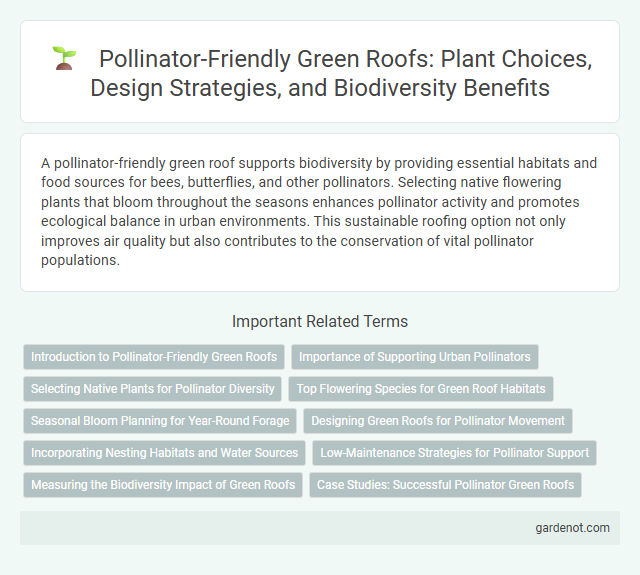A pollinator-friendly green roof supports biodiversity by providing essential habitats and food sources for bees, butterflies, and other pollinators. Selecting native flowering plants that bloom throughout the seasons enhances pollinator activity and promotes ecological balance in urban environments. This sustainable roofing option not only improves air quality but also contributes to the conservation of vital pollinator populations.
Introduction to Pollinator-Friendly Green Roofs
Pollinator-friendly green roofs integrate native flowering plants that support bees, butterflies, and other pollinators, enhancing urban biodiversity and ecosystem services. These roofs create essential habitats in cities, mitigating habitat loss and contributing to healthy pollinator populations critical for food production and plant reproduction. By selecting diverse, nectar-rich species, pollinator-friendly roofs optimize ecological benefits while improving air quality and urban microclimates.
Importance of Supporting Urban Pollinators
Pollinator-friendly green roofs provide essential habitats for bees, butterflies, and other pollinators in urban environments where natural landscapes are scarce. These roofs support biodiversity, enhance urban ecosystem services, and improve plant pollination critical for food production and ecological balance. Integrating native flowering plants on green roofs boosts pollinator populations, contributing to healthier cities and increased resilience against environmental stressors.
Selecting Native Plants for Pollinator Diversity
Selecting native plants for a pollinator-friendly green roof enhances biodiversity by supporting local bees, butterflies, and other pollinators adapted to the regional climate. Native species such as milkweed, coneflowers, and goldenrod provide essential nectar and pollen throughout the growing season, promoting pollinator health and increasing plant resilience. Incorporating a diverse mix of native flowering plants creates a sustainable habitat that contributes to overall ecosystem stability and urban green infrastructure effectiveness.
Top Flowering Species for Green Roof Habitats
Top flowering species for pollinator-friendly green roofs include Sedum, Echinacea, and Achillea, which provide abundant nectar and pollen throughout the growing season. Native wildflowers such as Solidago and Asclepias support diverse pollinator populations by offering critical habitat and food sources. Incorporating these species enhances biodiversity, promotes ecological balance, and improves urban sustainability on green roofs.
Seasonal Bloom Planning for Year-Round Forage
Pollinator-friendly green roofs designed with seasonal bloom planning ensure continuous forage for bees, butterflies, and other pollinators throughout the year. By integrating native flowering plants that bloom in succession--from early spring crocuses to late autumn asters--these roofs provide critical nectar and pollen sources during periods of scarcity. This strategic planting enhances urban biodiversity, supports pollinator health, and contributes to ecological resilience in metropolitan environments.
Designing Green Roofs for Pollinator Movement
Designing green roofs to support pollinator movement involves incorporating diverse native flowering plants that provide continuous nectar and pollen sources. Structural elements such as varied plant heights and connected green corridors facilitate navigation and habitat connectivity for bees, butterflies, and other pollinators. Optimizing substrate depth and moisture retention enhances floral health, directly influencing pollinator abundance and diversity on urban rooftops.
Incorporating Nesting Habitats and Water Sources
Incorporating nesting habitats such as bee hotels, native flowering plants, and undisturbed soil patches enhances the pollinator-friendly aspects of green roofs by providing essential shelter and breeding grounds for bees and other insects. Integrating water sources like shallow basins or drip irrigation systems ensures pollinators have consistent access to hydration, promoting their health and activity. These features collectively support biodiversity and contribute to sustainable urban ecosystems.
Low-Maintenance Strategies for Pollinator Support
Pollinator-friendly green roofs designed with native, drought-tolerant plants create low-maintenance habitats that support bees, butterflies, and other beneficial insects. Incorporating diverse flowering species with staggered bloom periods ensures continuous nectar and pollen sources, reducing the need for supplemental irrigation and fertilizers. Using lightweight, well-draining substrates minimizes water retention issues while promoting healthy root systems for sustainable pollinator support.
Measuring the Biodiversity Impact of Green Roofs
Pollinator-friendly green roofs significantly enhance urban biodiversity by providing essential habitats for bees, butterflies, and other pollinators within city environments. Measuring the biodiversity impact involves monitoring species richness, abundance, and pollination activity through systematic surveys and bio-indicators on the roof substrate. Data-driven assessments of floral diversity and pollinator visitation rates enable optimization of green roof designs to maximize ecological benefits and support urban ecosystem services.
Case Studies: Successful Pollinator Green Roofs
Case studies of pollinator-friendly green roofs, such as the Chicago City Hall and the Brooklyn Grange in New York, demonstrate significant increases in urban biodiversity and pollinator populations. These rooftops feature native flowering plants that support bees, butterflies, and other essential pollinators, contributing to local ecosystem resilience. Data from these projects indicate improved pollination rates and enhanced environmental benefits, validating pollinator green roofs as effective urban ecological interventions.
Pollinator-friendly roof Infographic

 gardenot.com
gardenot.com